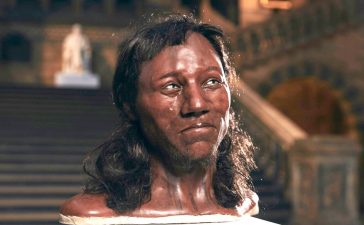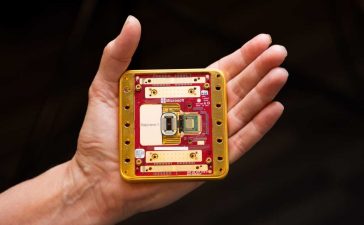NASA‘s James Webb telescope has found the most distant galaxy in the universe – giving an astonishing glimpse into the distant cosmic past.
Called JADES-GS-z14-0, the galaxy’s light has taken around 13.5 billion years to reach us – so the light started its journey just 300 million years after the Big Bang.
The newly-found galaxy measures 1,600 light years across – meaning light takes 1,600 years to travel from one end of it to the other.
Experts say JADES-GS-z14-0 is ‘remarkable for how big and bright it is’, with vast amounts of light being produced by its young stars.
The $10 billion James Webb telescope – which can ‘see back in time’ – has also found the second-most-distant galaxy in the universe, called JADES-GS-z14-1.

Using the NASA James Webb Space Telescope, scientists have found a record-breaking galaxy observed only 300 million years after the big bang

Galaxy JADES-GS-z14-0 existed just 300 million years after the big bang (which happened around 13.8 billion years ago)
Brant Robertson, astronomer at University of California, Santa Cruz and co-author of a new study, called the discovery ‘completely unanticipated’.
‘It is likely to be seen as the most significant extragalactic discovery with the James Webb space telescope to date,’ he said.
‘This galaxy [JADES-GS-z14-0] is truly a gem, and it points at more hidden treasures in the early universe.’
James Webb telescope – which is in space orbiting our sun – is often described as being able to ‘see back in time’, and although it sounds fantastical, it really is true.
Because the universe is so vast, light from one galaxy can take billions of years to reach another galaxy.
When the light from a distant galaxy finally reaches us, the light reveals a ‘snapshot’ of the galaxy as it appeared as it started its journey billions of years ago.
In this case, the light from JADES-GS-z14-0 – newly detected by the telescope – started its journey around 13.5 billion years ago, said co-author Dr Francesco D’Eugenio, astrophysicist at the University of Cambridge.
At the time, the distance between JADES-GS-z14-0 and when our galaxy (the Milky Way) would eventually form was only 2 billion light years.

Webb’s infrared capabilities allow it to ‘see back in time’ to the Big Bang, which happened 13.8 billion years ago. Light waves move extremely fast, about 186,000 miles (300,000 km) per second, every second. The further away an object is, the further back in time we are looking. This is because of the time it takes light to travel from the object to us

The James Webb Space Telescope orbits the Sun, 1 million miles away from the Earth at what is called the second Lagrange point or L2. When the light from a distant galaxy finally reaches James Webb telescope (which is positioned relatively near our sun), the light reveals a ‘snapshot’ of the galaxy as it appeared as it started its journey billions of years ago
But because the universe has since greatly expanded, the distance between JADES-GS-z14-0 and the Milky Way is now more like 34 billion years.
‘If we were able to freeze time right now and put a ruler between us and GS-z14-0, we would measure a distance of approximately 34 billion light years – that’s how much space has been added,’ Dr D’Eugenio told MailOnline.
By the time light from the most distant galaxies reaches Earth, it has been stretched by the expansion of the universe and shifted to the infrared region of the light spectrum, which Webb is equipped to detect with unprecedented clarity.
Many of the most luminous galaxies produce the bulk of their light via gas falling into a supermassive black hole.
But the team says the large size of JADES-GS-z14-0 means that the light must be produced by young stars.
Astronomers first spotted JADES-GS-z14-0 in early 2023, but they needed further observations to be sure it really was a record-breaker rather than a ‘confounding oddball’.
It was very close the other, less distant galaxy (JADES-GS-z14-1) that the two appeared to be part of one larger object.

JADES-GS-z14-0, the galaxy’s light has taken around 13.5 billion years to reach us – so the light started its journey just 300 million years after the Big Bang (which was 13.8 billion years ago)
Over the last two years, scientists have used James Webb to explore what astronomers refer to as ‘cosmic dawn’ – the period in the first few hundred million years after the big bang where the first galaxies were born.
These galaxies provide vital insight into the ways in which the gas, stars, and black holes were changing when the universe was very young
Since coming online in 2022, the Webb telescope has ushered in a new era of scientific breakthroughs, peering farther than ever before into the universe’s distant reaches.
It revealed its first set of images in July 2022, including a dying star cloaked by dust and a ‘cosmic dance’ between a group of galaxies.
Other astonishing images include the ‘Pillars of Creation’, Neptune’s rings, a ‘cartwheel galaxy’ and a stellar nursery known as the Tarantula Nebula.













